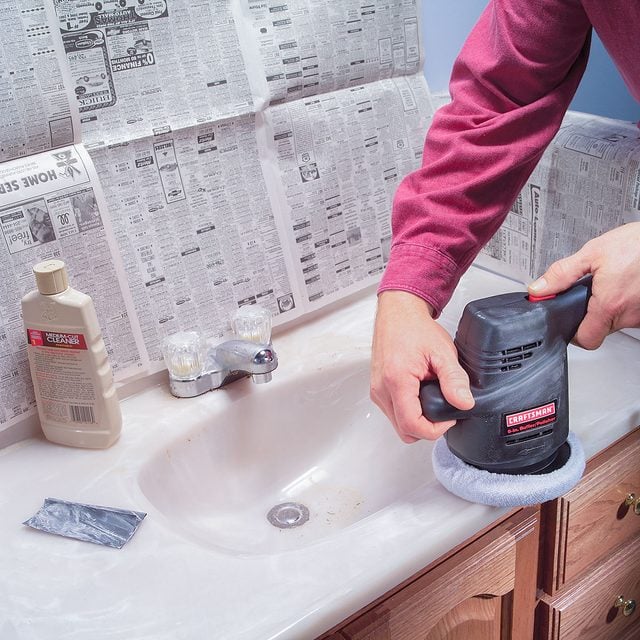Make cultured marble shine again.
Beginner
Introduction
You may think some home repairs are out of your league, but even beginner DIYers can make a scratched, dull-looking cultured marble top look shiny again. Cultured tops are made of crushed marble and polyester resin with a clear topcoat (called the gel coat). The gel coat, while durable, can become scratched and dulled over time.
I was disappointed by how quickly my cultured marble countertop lost its shine. The good news is I was able to restore its luster in under an hour with these steps. Here, pros Luke Haas from Elite Marble and Bart Stobienia from Euro Restorations provide some tips and tricks to achieve professional results when refinishing a cultured marble top.
When to Call a Pro
If the surface has deep gouges, scratches or chips, call a pro to repair and refinish the counter.
"If you can feel it easily with your fingernail, chances are it's past the gel coat," Haas says. In this case, he recommends professional repair.
Tools Required
- Handheld buffer/polisher
Materials Required
- 220 or 400 or 600 or 800-grit sandpaper
- Automotive polishing compound
- Cultured marble cream wax polish
- Dust mask
- Lint-free rags
- Microfiber cloth
- Mild detergent
- Painter's tape
- Plastic sheeting
- Protective gloves
Project step-by-step (6)
Clean and Prep the Area
- Clean the cultured marble surface with a mild detergent and water to remove dirt and residue build-up.
- Wipe the surface dry with a lint-free rag.
- Wrap the faucet base with painter’s tape to protect these surfaces while you work.
- Cover the walls and floor with plastic sheeting.
- Wear protective gloves and a dust mask while working.

Remove Surface Scratches
If your counter has noticeable scratches, follow this step to remove surface scratches. If it has more of a dulled finish, skip this step and go to the next one. “If you have a lot of surface hairline scratches, you should be able to just polish with the buffer,” Haas says.
The steps to remove surface scratches differ slightly for matte and gloss finish cultured marble.
For matte finish surfaces:
- Apply a small amount of water to damaged areas. “Adding water is very important,” Stobienia says. “You always want to wet-sand cultured marble.”
- Start with 220 grit sandpaper and wet-sand the surface to remove small, shallow scratches and stains.
- Switch to 400-grit sandpaper and sand these areas again.
- Inspect the surface. “If the sanded areas blend into the rest of the surface, stop sanding,” Haas says.
- If the sanded areas stand out from the rest of the surface, wet-sand the entire surface with 400-grit paper for continuity in the finish.
- Rinse the surface with water.
- Use a lint-free rag to dry the surface.
For gloss finish surfaces:
- Apply a small amount of water to damaged areas.
- Wet-sand the damaged areas “in a cross-hatch pattern,” Haas says, starting with 220-grit sandpaper.
- Sand the areas again using 400, 600 then 800-grit sandpaper.
- Rinse the surface with water.
- Use a lint-free rag to dry the surface.
Buffing
Buffing or polishing can remove any small scratches left from sanding or can remove lots of hairline scratches across the surface. Stobienia advises testing any products on an inconspicuous area first.
- Apply an automotive polishing compound like Meguiar’s Medium-Cut Cleaner to the surface with a lint-free rag.
- Using even, light pressure, work the rag in small, circular motions to buff the entire surface. Pay particular attention to spots that were sanded in the previous step.
- This step can also be done with a small power buffer. If using a power buffer, Haas advises using light pressure, adequate compound and to keep the buffer moving at all times. “If you leave it in one place for too long it can cause burns,” he says.
- When finished, wipe down the surface with a microfiber cloth.
Note: As an alternative, Stobienia often uses higher grit sandpaper instead of polishing compound. “I wet-sand with up to 1,500-grit sandpaper,” he says, which also buffs and polishes a cultured marble surface.
Protect New Finish
This final step is for cultured marble surfaces with a gloss finish. Skip this step for matte finishes.
- Apply a thin coat of cream wax polish, like Gel-Gloss, with a lint-free rag. This protects the surface and gives it a high-gloss finish. “It’s like waxing a car,” Stobienia says, leaving a shiny, protective surface.
- Be careful not to apply a thick coat of wax, as this can result in a foggy, cloudy finish.
Clean Up
- Remove painter’s tape from faucets and handle bases.
- Remove and dispose of plastic sheeting and protective gloves.
FAQs
What finish should I use after removing countertop scratches?
Try a finish wax like Gel-Gloss that will protect and restore the shiny luster to your high-gloss, cultured marble top.
Can you buff scratches out of Formica?
Yes. Very fine scratches can be buffed with car wax or furniture wax and a microfiber cloth. Deeper scratches cannot be buffed out and will require repair.
Does WD40 remove scratches from laminate?
While it doesn’t fix scratches in laminate, WD40 can be used to reduce the appearance of minor scratches.
About the Experts
Luke Haas is the owner of Elite Marble, a manufacturer of marble home products in Montello, Wisconsin. He has 35 years of industry experience and is a long-time board member of the International Cast Polymer Association (ICPA).
Bart Stobienia is the owner of Euro Restorations, a cultured marble refinishing company in Sarasota, Florida. He has over twenty years of industry experience.




















